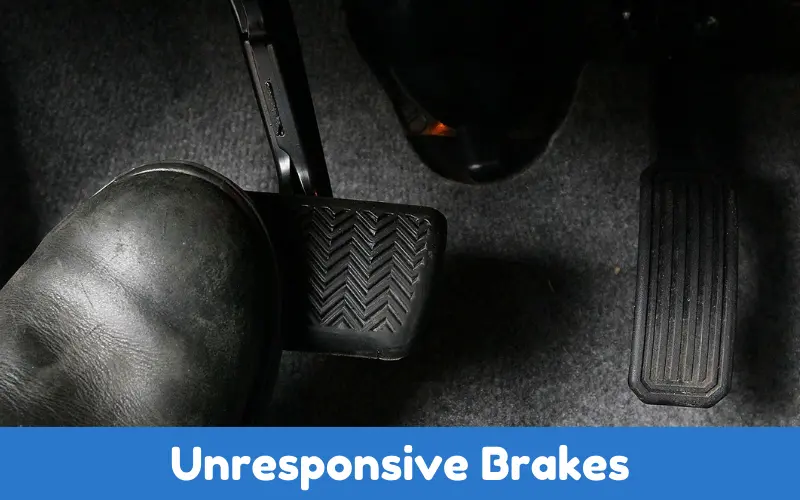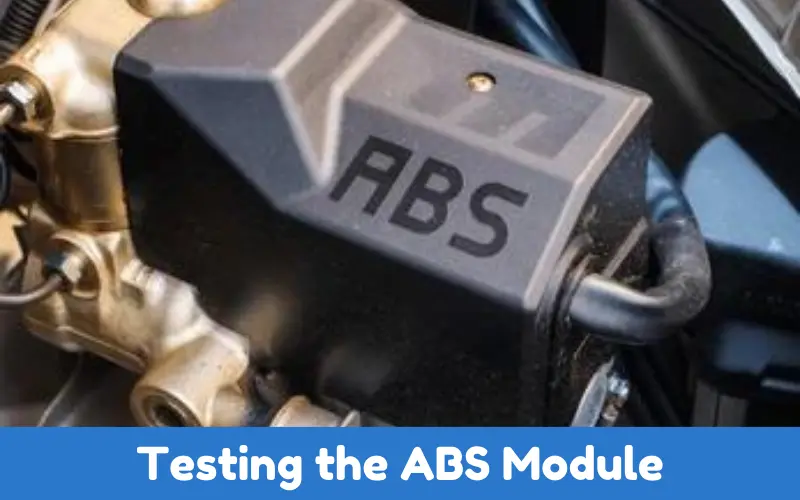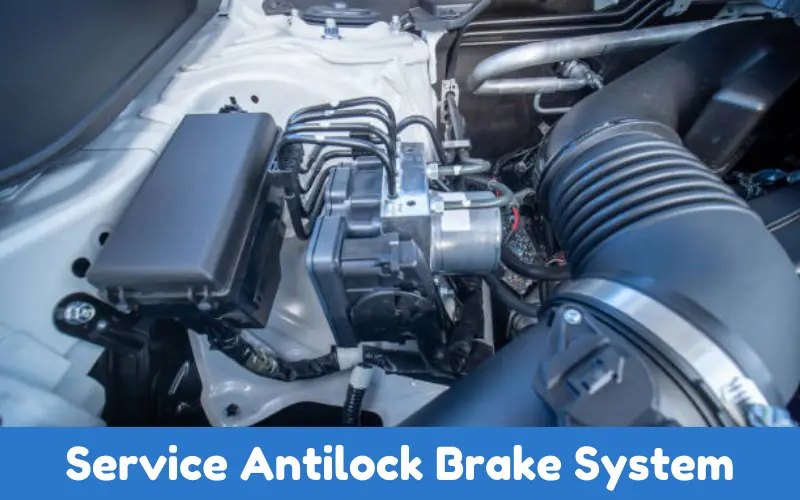Next on the list of cars and auto service is your vehicle’s service antilock brake system (ABS). The ABS system’s main objective is to keep the wheels from locking up when braking, which can cause dangerous wheel skidding and a loss of control on the road.
This safety feature is especially important in slippery conditions where vehicles need to keep traction on the road.
In this blog, we will discuss how to fix service antilock brake system warning light. How does ABS works and how to maintain your vehicle’s ABS system properly.
Topic Summary
What Does Service Antilock Brake System Mean?
If your dash lights come on showing Service Antilock Brake System, it means your antilock brake system has a problem.
The antilock brakes (ABS) are a hugely important safety system in your vehicle. Antilock brake system makes sure that, when you hit the brakes, the wheels don’t lock up and skid, even on slippery roads.
The message indicates that the antilock braking system (ABS) is not working properly, which may affect the braking performance of your car in urgent situations.
The main causes of the antilock braking system (ABS) fault include the failure of the wheel speed sensors, the problem of the ABS controller, or the low level of the brake fluid.
With this warning, you need to handle the situation as soon as possible by taking your car to a mechanic who can check for any trouble and fix the problem so that your vehicle is safe and ABS is back to normal again.
Failure to do so may compromise the effectiveness of your braking system and potentially cause risk to your driving, especially in bad weather conditions.
How Does Antilock Braking System Work?
The diagram shows a schematic of an antilock braking system that contains five important parts: the engine, a wheel speed sensor, an ABS module, and 2 opposite hydraulic valves on the brake calipers.
A diagram describes, in brief, how these various parts behave while providing their services. From the diagram, we can identify the structure of these components, and we can define their functions as follows:
Wheel Speed Sensors: A speed sensor is used to monitor the wheel speed of each wheel and sends the information to the antilock braking system module.
ABS Module: Takes the input from the wheel speed sensors and activates the ABS if it finds that one or more wheels are decelerating faster than the others (while also taking into account the pedal position, speed, etc.).
Hydraulic Valves: The hydraulic valves in the brake lines, which are controlled by the ABS module, regulate the brake pressure to stop the wheels from locking while still allowing the driver to maintain control of the vehicle when braking.
What Causes Service Antilock Brake System Warning Light?
After some time of use, the elements of the antilock braking system (ABS) may wear out or malfunction, which could cause safety problems. Here are a few key indications of when your ABS might need service.
ABS warning light
If the system isn’t working, the antilock braking system warning light on your dashboard will illuminate. Either a fault sensor or an ABS module could be the source of the problem. The ABS can also be an indicator of low brake fluid.
Unresponsive Brakes
Antilock braking system is engaged, but you’re not able to stop the car as quickly as you should, especially on a wet road.

You may get difficulties. You should seek help as soon as possible.
Shaking Brake Pedal
When the antilock braking system (ABS) operates, it is normal to feel a shaking under your foot on the brake pedal.
But if this is felt while you’re slowing down normally and there are no problems under acceleration, then you might have an issue with your ABS.
How To Fix Service Antilock Braking System Light
A qualified mechanic must do servicing of the antilock braking system system, but here’s an overview of what should be done:
1. Diagnostic Check
The mechanic will connect a piece of diagnostic equipment to read any stored error code from the antilock braking system (ABS) module, which will tell him which component to focus on.
2. Check Wheel Speed Sensors
The sensors are examined for dirt, debris, or damage. Sensors that are dirty, damaged, or flawed are cleaned or replaced.
3. Checking Brake Fluid Levels
If the brake fluid is low, it may cause problems with the ABS. Checking for leaks: The mechanic will also check for leaks during this procedure and replace the brake fluid if required.
4. Testing the ABS Module
You may want to test or have the ABS module recalibrated. And in some cases, it should be replaced.

5. Inspecting Hydraulic Valves
The hydraulic valves in the brake lines are checked for proper function. Any faulty hydraulic valves are replaced.
6. Road Test
Test drive after service to check if the antilock braking system (ABS) works properly in the field.
7. Importance of Regular Maintenance
You don’t want to find yourself in an emergency when it would be most needed, with ABS that is not functioning due to poor maintenance of the braking system in your car.
Is It Safe To Drive without Antilock Braking System?
Driving without would not necessarily be unsafe as long as you know the proper braking technique in the event of an emergency.
Essentially, ABS (Antilock Braking System) helps to prevent the wheels from locking up during hard braking, thereby allowing the driver to maintain steering control and maneuverability and reducing the possibility of a skid.
In the absence of ABS, the driver would need to modulate (control) the brakes to prevent lockup, particularly on slippery surfaces such as rain, snow, sand, gravel, etc.
This requires quite a different technique from slamming on the brakes. It is done briskly (not hard) and evenly.
Assuming your car doesn’t have ABS, threshold braking will help unless your vehicle is at an extreme angle relative to the road, i.e., at a 90-degree turn.
To treat braking correctly, you apply pressure to the brake pedal until the wheels start to lock, then ease off slightly. The idea is to brake until just before the wheels start to lock, which means brake as hard as you can.
The other key is to maintain a safe following distance and then match your speed to the conditions of the road. Driving without antilock braking system (ABS) is a matter of paying more attention and being more careful.
FAQs on Service Antilock Brake System
What is the Primary Function of the Antilock Brake System (ABS)?
The main job of antilock braking system (ABS) is to prevent wheel lockup during braking, particularly on slippery surfaces, thereby helping to maintain traction and direction. It does this by varying the brake pressure acting on each wheel individually.
Can I Drive My Car If the ABS Warning Light is On?
If the ABS warning light is on, you can still drive the car, but you should get it checked out as soon as you can. The light means there’s a problem with the antilock braking system (ABS), and while your regular brakes will still work, they might not do so as safely, particularly if you need to make an emergency stop.
What Should I Do If I Feel the Brake Pedal Pulsating?
It’s normal for the pedal to thump and operate against resistance if the antilock braking system (ABS) is active. If it’s not, and you hit your brakes even on an unyielding surface, it could be a sign that the ABS or another part of your braking system needs to be checked out by a mechanic.
How Often Should the Antilock Braking System be Serviced?
The antilock braking system (ABS) should be checked during regular service inspections, along with brake service intervals. If you observe the ABS warning light or get an idea that something is wrong with how the ABS operates in your vehicle, take it immediately to be serviced by an authorized technician.
Can I Replace ABS Components Myself?
Given the complexity of ABS components and their importance to vehicle safety, it’s best to leave repairs and replacements to a professional mechanic. Improperly servicing the antilock braking system (ABS) or trying to do the work yourself can cause damage or dangerous driving conditions.
Conclusion
Without the antilock braking system (ABS), your car cannot brake safely. Being aware of how the ABS works and of the signs when it needs servicing may just keep you safe on the road. If you believe your ABS is faulty, you need to have it checked out as soon as possible.

